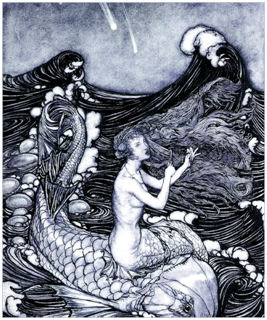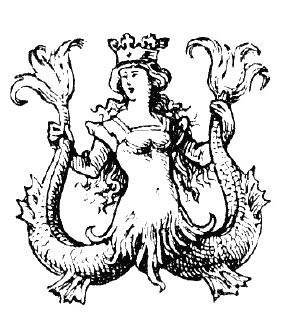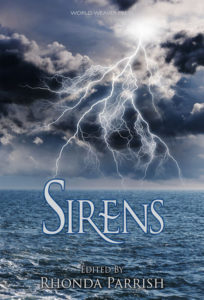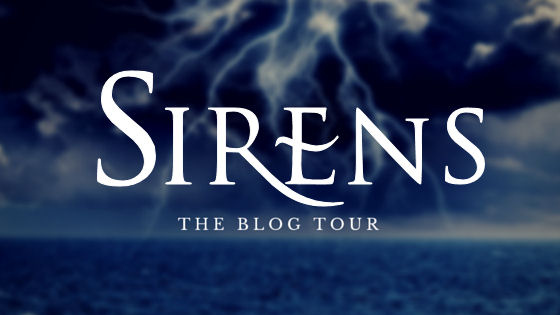Of Sirens and Sorrow – Part 1
Amanda Kespohl

Arthur Rackham (1908).
The ocean. So beautiful. So mysterious. So “full of fish,” as Kevin Kline’s character from French Kiss observed.
And merfolk, maybe?
For thousands of years, man has thought so. As early as 2,000 B.C., the Babylonians worshipped a half-fish, half-human deity by the name of Era or Oannes.[1] From that time, tales of merfolk have cropped up across many cultures: from Sovann Macha, the mermaid of the Hindu belief system[2]; to the Tritons of Greek mythology[3]; to Yemajá, the mermaid who is the mother of all according to the traditions of Cadomblé, which originated in Africa.[4]
Yet often folklore concerning mermaids also involves great sorrow. Why is it that we associate merfolk with tragedy? Perhaps a review of some popular tales can help us find the answer.
MELUSINA / MELUSINE

At first blush, Melusina doesn’t seem to fit in our list of fictional mermaids. Although her mother was a water fairy associated with a fountain or spring, Melusina began life as merely another fetching fairy lass.[5] However, as a teenager, she inspired maternal wrath by mistreating her human father. For this sin, her mother cursed her to be a fish (or a snake in some tales) from the waist down every Saturday.
Afterwards, Melusina wandered for a time, occasionally stopping to participate in fairy revels. At one such gathering, she met a handsome human count. As you might expect, the count fell in madly love with her and asked for her hand in marriage. Melusina said yes, but with one caveat—after their marriage, he must make no attempt to see her on Saturdays. Whatever he thought of this strange condition, the smitten count could only agree. He took his bride back to his castle, and they were wed.
Predictably, the count was unable to keep his word. After years of being happily married, he was persuaded to peek in on his wife one Saturday. In some tales, curiosity got the better of him, while in others, he feared his wife was having an affair. As he peered through a crack in her bed chamber wall, he spied his wife in the bath. At first glance, she appeared to be her normal, lovely self. Upon closer inspection, he realized that she had the tail of a fish (or serpent) from the waist down. Oddly enough, his reaction wasn’t, “Holy crap, I married a mermaid!” No, the count sailed right past shock to guilt. He had broken his wife’s confidence, and if she found out, she would leave him. Wisely, the good count opted to stay mum.
He might’ve gotten away with it if it wasn’t for those meddling kids. Some time later, one of his children killed another, and the count was grief-stricken. Melusina came to comfort him. Unwisely, he lashed out at her, suggesting that the murderous son had inherited his nature from his fishy (or serpentine) mother. Sadly, Melusina rebuked her husband for his betrayal and disappeared. The count never laid eyes on his beloved wife again.
Interestingly enough, some sources suggest that Melusina is the inspiration for the Starbucks logo.[6] If true, this means that all the poor count needed to do to see his wife again someday was live long enough to order a half-caff, no foam, mocha latte.
Now that’s a tragedy.
Amanda Kespohl is an appellate judicial clerk who writes bench summaries by day and fantasy novels and short stories by night. She lives in Tallahassee, Florida with her beagle, Bailey, and spends her spare time reading fairy tale retellings and Marvel comic books. Check out her website at https://amandakespohl.wordpress.com/ or find her on Twitter at @amandakespohl.

Reserve Your Copy Now!
[1] Radford, Benjamin. “Mermaids and Mermen: Facts and Legends.” Live Science. Web. May 22, 2016. http://www.livescience.com/39882-mermaid.html.
[2] “Sovann Macha—The Mermaid of the Hindu Mythology.” http://mamiwatafilm.com/sovann-macha/; “Suvannmaccha.” Wikipedia, Wikimedia Foundation. Web. May 27, 2016. https://en.wikipedia.org/wiki/Suvannamaccha.
[3] “Triton.” Greek Mythology. Web. May 27, 2016. http://www.greekmythology.com/Myths/Figures/Triton/triton.html.
[4] Jan Sochor Photography. Yemanjá: Candomblé Cult in Bahia (Recôncavo Baiano, Bahia, Brazil). Feb. 2012. Web. May 27, 2016. http://www.jansochor.com/photo-blog/yemanja-candomble-cult-bahia-brazil; “Yemaya, Mother Goddess of the Ocean.” A-Muse-ing Grace: The Magical Art of Thalia Took. Web. May 27, 2016. http://www.thaliatook.com/AMGG/yemaya.php.
[5] This whole section is based on a review of this source: Ashliman, D.L. “Melusina (Melusine, Mélusine).” Folklore and Mythology Electronic Texts. University of Pittsburgh. Web. May 27, 2016. http://www.pitt.edu/~dash/melusina.html.
[6] Rubio, J’aime. “Who Was Melusine? Water Fairy, Mermaid or Serpent?” ORIGINS- “What Does History Say?” July 17, 2012. Web. May 27, 2016. http://whatdoeshistorysay.blogspot.com/2012/07/who-was-melusine-water-fairy-mermaid-or.html; Pyrdom, Carl. “The Other Starbucks Mermaid Cover-Up.” Got Medieval. Aug. 31, 2010. Web. May 27, 2016. http://www.gotmedieval.com/2010/08/the-other-starbucks-mermaid-cover-up.html.

